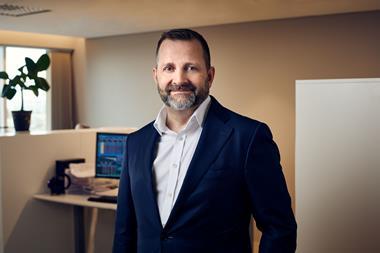Perhaps the most
fundamental proposition
of the multi-manager
sector is good
performance at lower
risk. Thanks to a bear market of a
length and depth to put pension
provision in crisis all over
Europe, and a growing demand
for professional manager
selection and better
accountability, multimanagement
is increasingly seen
as a way to package a well
diversified active portfolio, with
maximum efficiency and top
quality reporting, for the smaller
institutional manager. Through
funds of funds, enthusiasm for
the concept is also developing on
the retail side.
A number of advantages are
claimed for the smaller pension
fund. In addition to better diversification
and the ability to outsource
fund selection to a company
with specialist expertise,
multi-management offers efficiency
of structure, maximum
economies of scale, effective
active management to investors
whose size might otherwise limit
them to the indexed approach,
bespoke solutions to a range of
investment objectives through a
‘building block’ fund range,
access to managers which might
otherwise be inaccessible to the
smaller institution, and consistency
of selection worldwide.
Multi-management is not a very
new concept but it is only in the
last few years that it has begun to
get into its stride. Assets stood at
$680bn (€531bn) worldwide at the
end of 2003. Growth has run at a
rate of 14% a year overall, and
8.5% in the institutional market,
since US multi-management data
analyst Cerulli Associates began to
collect figures five years ago.
Cerulli managing director Ben
Phillips expects these rates to be
maintained in the group’s next
Quantitative Update.
Cerulli estimates that total US
MM assets under management
totalled $356bn at the end of 2004,
and could reach $551bn by the
end of 2008. Institutional multimanagement
assets in the US are
expected to enjoy a compound
annual growth rate of 4.4%
between now and 2008. Institutional
manager of manager assets
formed 21% of total US MM assets
in 2003, compared to 24% in 2002
and 23% in 2001.
Phillips points out that, though
big in absolute terms, multi-management
in the US is not enormous
as a percentage of the total institutional
asset pool. MM initially
faced reluctance among pension
fund clients who did not want to
relinquish the ability to fire fund
managers. Since most MM
providers started life as pension
fund consultants, conflict of interest
was also an issue. This was no
doubt a factor in making top US
consultant SEI abandon the consultancy
role to nail its colours to
the MM mast a decade ago.
The bear market has changed
people’s perspective: because of
falling values more funds have
found themselves in the $50-100m
range most suited to the multimanager
market, and downsizing
has reduced the resources funds
need to make their own investment
selection. Multi-management
providers in the US, led by
Russell, SEI and Northern Trust,
have responded by promoting
themselves more aggressively.
Glyn Owen, head of multimanagers
at RMB MultiManagers,
feels that “a broad medium-term
trend is in place. Multi-management
will remain one of the big
growth areas”. He cites changes in
the fund management industry –
the demise of the traditional balanced
approach, the migration of
talent to small specialist firms
and the recognition that no one
firm can meet all fund management
needs. RMBI MM is still
building its constituency in the
UK but with sizeable assets under
management in its home territory
of South Africa, it is an indicator
of the widely international nature
of the multi-management market.
The recent announcement by
Mercers that it intends to market
multi-management products outside
the US underlines this.
Antony John is the managing
director at independent UK multimanagement
product provider
IMS. In the classic management
consultancy ‘forming-stormingnorming’
progression, he sees
multi-management as being at the
storming stage: “A lot of new
entrants, lots of brand hype but not
much visibility in terms of the substance
of what is being delivered.”
There are signs that consolidation
may be an issue in this market.
UK fund manager Artemis
recently decided that multi-management
was not a core part of its
business and sold its operation to
Credit Suisse Asset Management,
which itself had built up funds of
£502m (€737m) in the previous
three and a half years. CSAM’s UK
flagship Constellation fund,
which invests in the funds of fund
management boutiques, has
achieved much admiration
thanks to a dramatically successful
performance record.
“We do not at present operate in
the consultancy world and have
no strategy to move into it, but we
have had some enquiries because
our performance has been stronger
than some MM providers in that
field”, says CSAM joint head of
MM services Robert Burdett.
CSAM has three Luxembourg
funds of funds which were
launched in February 2003 as a
prelude to UCITS III. The funds are
already registered in most EU
states and distribution is through
bancassurance institutions – a
popular route into the multi-management
market which has also
seen initiatives such as the tie up
between Russell and Société
Générale and BNP Paribas’s move
to provide a wide range of multimanagement
services Europe-wide
through subsidiary CFM.
IMS does much of its business
through institutional clients that
in turn package funds for use in
retail products. The Aviva multimanager
Sicav is an example. To
John, offering funds which sit in
the standard retail universe is “an
invaluable shop window for our
skills and capabilities.” The
group’s largest fund, IMS Select, is
one of only two in the UK with an
S&P AAA fund rating.
IMS offers all three of the main
multi-manager approaches:
funds of funds, manager of managers
and hybrids. Funds of funds
are typically offered to the retail
end user. Their main advantage,
says John, is their ability to give
broad diversity for lower asset
pools. Funds of funds brand
awareness also makes them easier
for the retail investor to understand,
though institutional
providers tend to look down their
noses at funds of funds, on the
basis that the level of double
charging involved - which has
been a source of debate in the
retail arena - is not appropriate
for the institutional investor.
Manager of managers are the
institutional heartland of the sector,
though IMS is finding that
they are “migrating also to the
retail space because of costs”. Manager
of managers are typically used
for larger asset pools, and the
choice of managers has to be very
good, as well as closely monitored,
because, says John, “the frictional
costs of moving are very high”. In
his view, though the costs in a
retail fund of funds are higher,
they offer better diversification of
manager style, geographical
region and market capitalisation
and “the speed with which they
can engineer change more than
offsets the extra cost”.
Hybrid arrangements use a core
of segregated managers with a
number of satellite funds. John
can see the case for these becoming
stronger, and points to the Skandia
hybrid product in the UK, as well
as institutions which are using
hybrids in defined contribution
pension schemes.
Within the pension fund arena
a range of multi-management
approaches is on offer. The
emerging standard is where the
multi-management provider
offers a set of funds that are used
as building blocks to meet the
investment objectives and risk
parameters of the client concerned,
who might typically be
introduced by a consultant. Some
groups will get involved in the
process of setting objectives.
Punter Southall’s multi-management
division, PSolve, is a case in
point, as is Bramdean Asset Management,
a multi-management
business set up in December 2004
and headed by Nicola Horlick.
Other companies, SEI being the
prime example, feel that the two
activities are incompatible.
In Europe, multi-management is
“beginning to take hold, though
some markets are further along
than others”, says Greg Rodgers,
SEI’s director of institutional business
for continental Europe. Different
conditions apply in different
markets, making some more
receptive than others. In Switzerland,
for example, the well-established
use of hedge funds of funds
has stimulated receptiveness to
multi-management in general,
while France’s massive state and
industry-wide schemes have been
slower to react.
In Germany, says Stephan
Römer, director of SEI’s business
development for Germany,
Switzerland and Austria, “the
multi-management market place
is still in its infancy. A lot of education
is necessary. There is still a
lot of confusion over the concept.”
This is particularly so
given the similarities between
multi-management and the German
master KAG, a combined
reporting transaction vehicle in
the larger institutional market.
However, local players clearly see
a good future for multi-management:
Deutsche Asset Management
and major Frankfurt consultancy
RMC have recently
joined forces to provide a joint
multi-management service.
From Römer’s viewpoint, the
main driver for the multi-management
sector in Europe is “very
much about risk control – much
better portfolio construction,
reduction of risk, and outsourcing
the process of hiring and firing
managers”.
Rodgers adds: “A pension fund
will forego 20% outperformance
in exchange for reducing downward
volatility. Pension funds do
not want to report a big drop in
values.”













